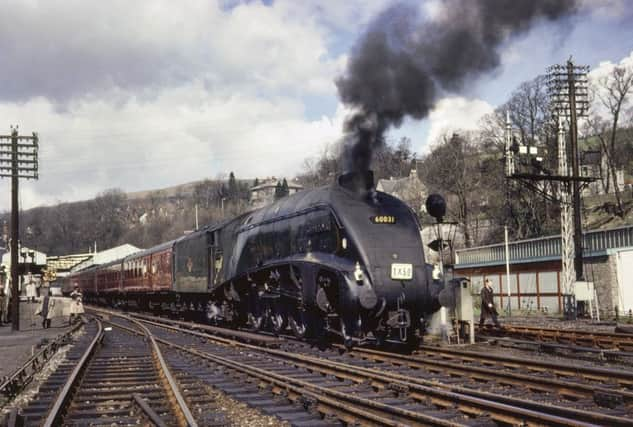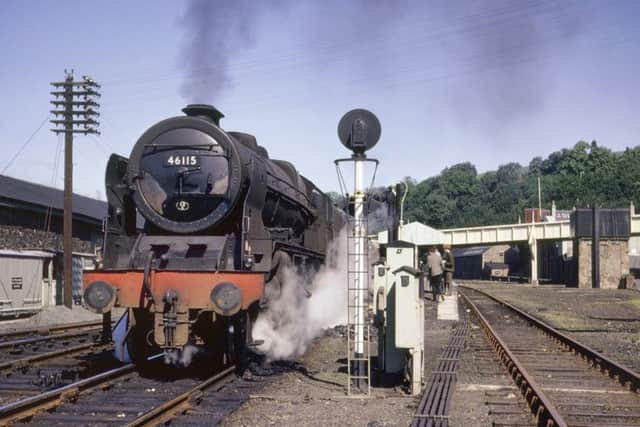Borders railway reopening ends historic injustice


It was among hundreds of miles of Scottish tracks axed in the Beeching cuts, with hundreds more earmarked but later saved from the chop.
By contrast, there promises to be a scramble to get on board when part of the line re-opens on Sunday. The first trains will be three times their normal length, queuing systems will be in place, and all 17 special steam trips have sold out.
Advertisement
Hide AdAdvertisement
Hide AdIt comes as part of a remarkable reversal of fortune for Scotland’s railways. Rather than being consigned to history, the network has never been as popular, carrying some 90 million passengers a year despite being a fraction of its past size.


However, renewed confidence in train travel is a recent phenomenon, and doubts about the viability of re-opening the line from Edinburgh to Tweedbank, south of Galashiels, have dogged the project.
In fact, even the original 99-mile route to Carlisle, completed in 1862, was not considered cost-effective over its full length. The southern section covers largely uninhabited territory, and campaigners hoping to see the whole line re-opened believe the line should follow a more populous route instead.
The North British Railway (NBR) coined the “Waverley” name, after the Sir Walter Scott novels, to help market the line.
Advertisement
Hide AdAdvertisement
Hide AdIt passes close to Abbotsford, the author’s home near Tweedbank, and, as Peter Ross relates in his new book Borders Railway – The Return Journey, steam locomotives were given names out of Scott, such as Wandering Willie and Wizard Of The Moor.
Ross wrote: “A lovely NBR poster of 1907 offered English passengers the chance to experience, ‘The Home and Haunts of Sir Walter Scott, without having to sacrifice any comforts’. These trains, it promised, came complete with, ‘Dining Cars, Sleeping Cars, and Lavatory Carriage’.”
However, that heyday was long gone when Dr Richard Beeching recommended closure in 1963 as part of radical cuts to stem the railways’ massive losses.
The last of the line’s local and long-distance traffic was the infamous final train, the Edinburgh-London St Pancras sleeper service on 5 January 1969.
Advertisement
Hide AdAdvertisement
Hide AdIt provided the climax of growing protests at the closure, with campaigners blocking the tracks at Newcastleton.
An 11,000-signature petition taken to 10 Downing Street by then Borders MP David Steel and campaigner Madge Elliot weeks earlier had been to no avail.
Protesters had already loaded a commemorative coffin on to the sleeper at Hawick before it reached the blockade.
The disturbance led to the local minister, one of the ringleaders, being held by the police.
Advertisement
Hide AdAdvertisement
Hide AdThe impasse was resolved by David Steel, who was on the train, brokering the release of the minister in return for the crowd letting the train pass.
The MP had already attempted in vain to convince the Labour government to retain the Edinburgh-Hawick section of the line, which carried virtually all its passenger traffic.
Lord Steel told The Scotsman this week: “I had got the local authorities to finance a study which recommended keeping the line open to Hawick with single tracking and de-manning smaller stations.
“The secretary of state, Willie Ross, was in favour, but he was a curmudgeon and he never said so, otherwise we could have kept that line at much less expense.”
Advertisement
Hide AdAdvertisement
Hide AdDavid Spaven, author of Waverley Route – The Battle For The Borders Railway, said: “Hawick is the town that lost the most from the closure, and its population has been in decline since.”
Overnight, journeys to Edinburgh took 50 per cent longer – by bus. The effect on other places, like Newcastleton, was even more dramatic, going from direct trains to London to a handful of local buses a day.
However, within months, the first of a series of campaigns to restore the railway was launched, with the initial move an abortive attempt to take over the line as a going concern.
A turning point came in 1998 when the UK government announced plans for a feasibility study, which culminated in MSPs approving plans for a 30-mile line to Tweedbank, just south of Galashiels, in 2006.
Advertisement
Hide AdAdvertisement
Hide AdConstruction of the new line stirred powerful emotions in the Borders, Ross found when researching his book. He said: “People were leaning over bridges, some in tears because they are so happy to see the line come back. There is a sense of historic injustice of the line being closed.
“A lot of workers feel there is a moral force in the work they have been doing. They have a sense of righting a wrong.”
However, Dr Ann Glen, author of the newly-published The Waverley Route - Its Heritage and Revival, said: “I do not think it’s ever going to be one of the greatest scenic journeys of the world as some would like to present it as. But it’s pleasant, bonny countryside.”
l Watch The Scotsman’s Google Hangouts on the line re-opening at www.scotsman.com/video